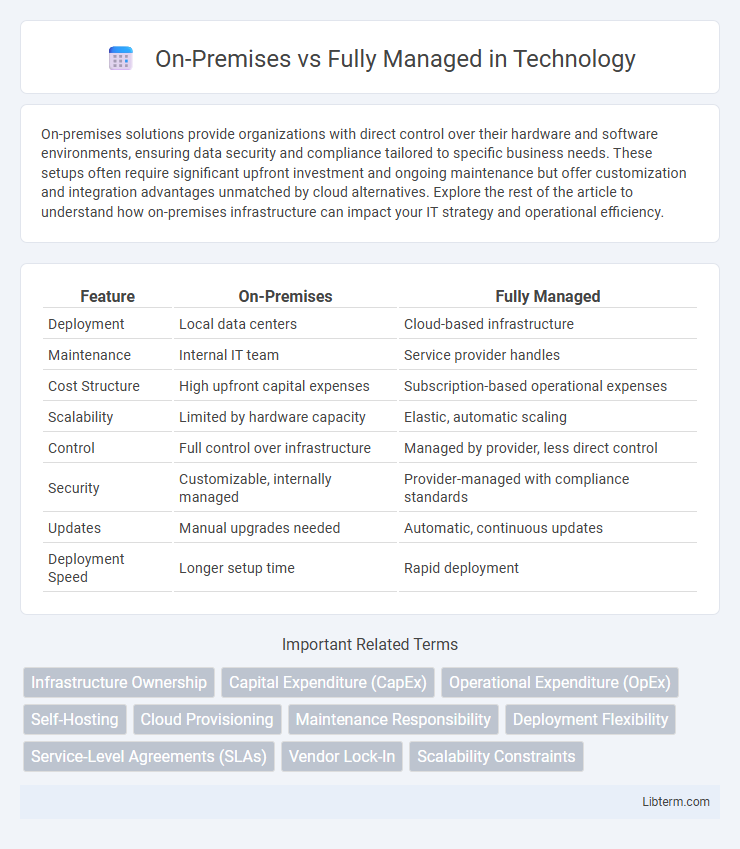On-premises solutions provide organizations with direct control over their hardware and software environments, ensuring data security and compliance tailored to specific business needs. These setups often require significant upfront investment and ongoing maintenance but offer customization and integration advantages unmatched by cloud alternatives. Explore the rest of the article to understand how on-premises infrastructure can impact your IT strategy and operational efficiency.
Table of Comparison
| Feature | On-Premises | Fully Managed |
|---|---|---|
| Deployment | Local data centers | Cloud-based infrastructure |
| Maintenance | Internal IT team | Service provider handles |
| Cost Structure | High upfront capital expenses | Subscription-based operational expenses |
| Scalability | Limited by hardware capacity | Elastic, automatic scaling |
| Control | Full control over infrastructure | Managed by provider, less direct control |
| Security | Customizable, internally managed | Provider-managed with compliance standards |
| Updates | Manual upgrades needed | Automatic, continuous updates |
| Deployment Speed | Longer setup time | Rapid deployment |
Introduction to On-Premises vs Fully Managed Solutions
On-premises solutions involve hosting software and hardware within a company's own infrastructure, offering greater control over data security and customization. Fully managed solutions are cloud-based services where the provider handles maintenance, updates, and support, enabling scalable and cost-effective operations. Businesses prioritize factors such as control, compliance, cost, and ease of deployment when choosing between these approaches.
Defining On-Premises and Fully Managed Services
On-premises services involve hosting and managing IT infrastructure within a company's physical location, requiring dedicated hardware, software, and in-house IT staff for maintenance and security. Fully managed services outsource these responsibilities to third-party providers who handle setup, monitoring, updates, and troubleshooting remotely, ensuring optimized performance and scalability. Choosing between on-premises and fully managed solutions depends on factors such as control preferences, budget constraints, compliance requirements, and IT resource availability.
Key Differences Between On-Premises and Fully Managed
On-premises solutions require organizations to handle all aspects of infrastructure, including hardware maintenance, security, and software updates, resulting in greater control but increased resource demands. Fully managed services shift these responsibilities to the provider, offering scalable, automated maintenance and enhanced uptime while reducing internal IT overhead. Key differences involve cost structure, with on-premises incurring higher upfront capital expenditures versus the subscription-based pricing of fully managed services, and data control, where on-premises offers complete local data governance compared to cloud-provider managed environments.
Cost Comparison: On-Premises vs Fully Managed
On-premises solutions require significant upfront capital expenditure for hardware, software licenses, and infrastructure maintenance, resulting in higher initial costs. Fully managed services operate on a subscription or pay-as-you-go model, converting capital expenses into predictable operational costs with reduced IT staffing requirements. Over time, fully managed options often provide cost savings through scalability, minimized downtime, and lower maintenance overhead compared to on-premises deployments.
Security Considerations for Both Approaches
On-premises solutions offer complete control over security protocols and data access, enabling organizations to implement tailored defenses and comply with strict regulatory requirements. Fully managed services provide advanced security features like real-time threat detection, automated patching, and compliance certifications, leveraging cloud provider expertise to minimize vulnerabilities. Both approaches require strong identity and access management, encryption standards, and regular audits to mitigate risks effectively.
Scalability and Flexibility Factors
On-premises solutions offer limited scalability and flexibility due to physical hardware constraints and fixed resource capacities, requiring significant investment for upgrades. Fully managed cloud services provide dynamic scalability by automatically adjusting resources based on demand and offer greater flexibility with seamless integration and rapid deployment options. Businesses prioritizing rapid growth and agile operations benefit from the superior adaptability of fully managed environments compared to traditional on-premises setups.
Performance and Reliability Insights
On-premises infrastructure offers direct control over hardware, enabling tailored performance tuning and minimizing latency for critical applications, while fully managed services provide scalable, automatically optimized environments with built-in redundancy to ensure high reliability. Performance in fully managed solutions benefits from continuous monitoring and adaptive resource allocation, reducing downtime and maintaining consistent throughput. Reliability insights reveal that on-premises setups require proactive maintenance and specialized expertise, whereas fully managed platforms leverage provider SLAs and global failover capabilities to enhance system availability.
Maintenance and Support Requirements
On-premises solutions demand extensive internal maintenance and dedicated IT support teams to handle hardware updates, software patches, and troubleshooting. Fully managed services transfer these responsibilities to the service provider, ensuring continuous monitoring, automatic updates, and expert support with minimal client involvement. This shift significantly reduces operational overhead and enhances system reliability by leveraging provider expertise and proactive maintenance protocols.
Ideal Use Cases for On-Premises vs Fully Managed
On-premises solutions are ideal for organizations requiring strict data control, low-latency access, and compliance with regulatory frameworks such as HIPAA or GDPR. Fully managed services suit businesses seeking scalability, reduced IT overhead, and rapid deployment, often benefiting SaaS companies and startups prioritizing agility. Enterprises with legacy infrastructure or sensitive intellectual property typically prefer on-premises setups, while those emphasizing cloud-native innovation opt for fully managed environments.
Choosing the Right Solution for Your Business
Selecting between on-premises and fully managed solutions hinges on your business's control requirements, budget, and resource availability. On-premises setups offer greater customization and security by hosting infrastructure internally, ideal for companies with robust IT teams and strict compliance needs. Fully managed solutions provide scalability and reduced operational overhead, benefiting businesses aiming for rapid deployment and ongoing expert support without the complexity of in-house maintenance.
On-Premises Infographic

 libterm.com
libterm.com